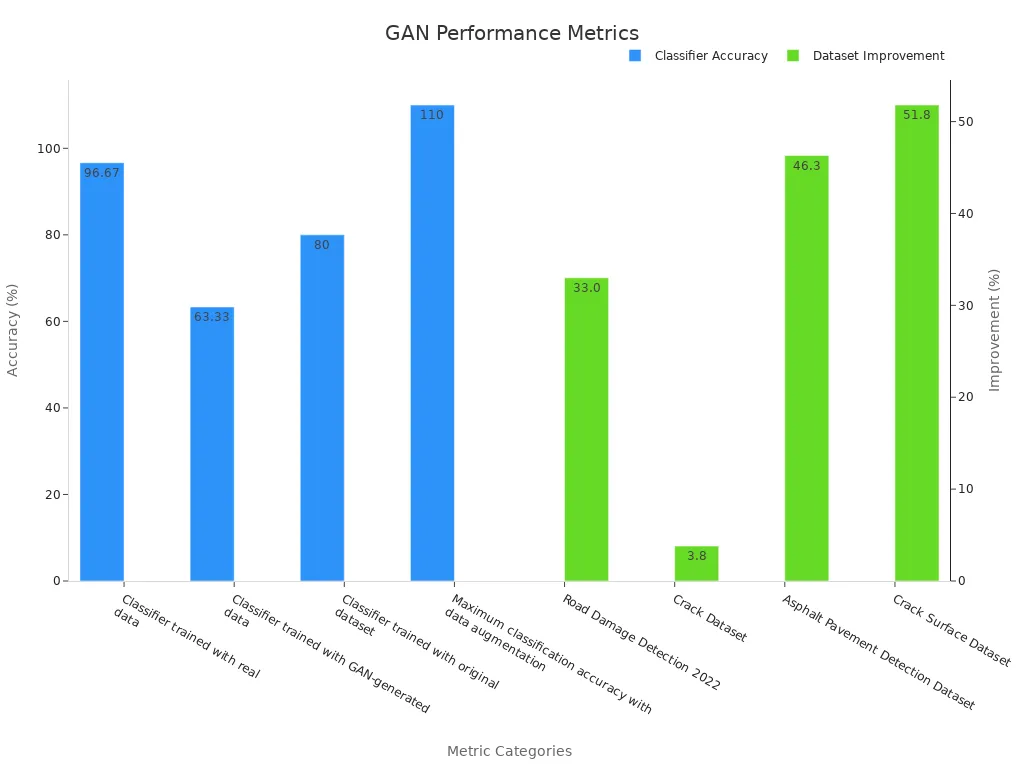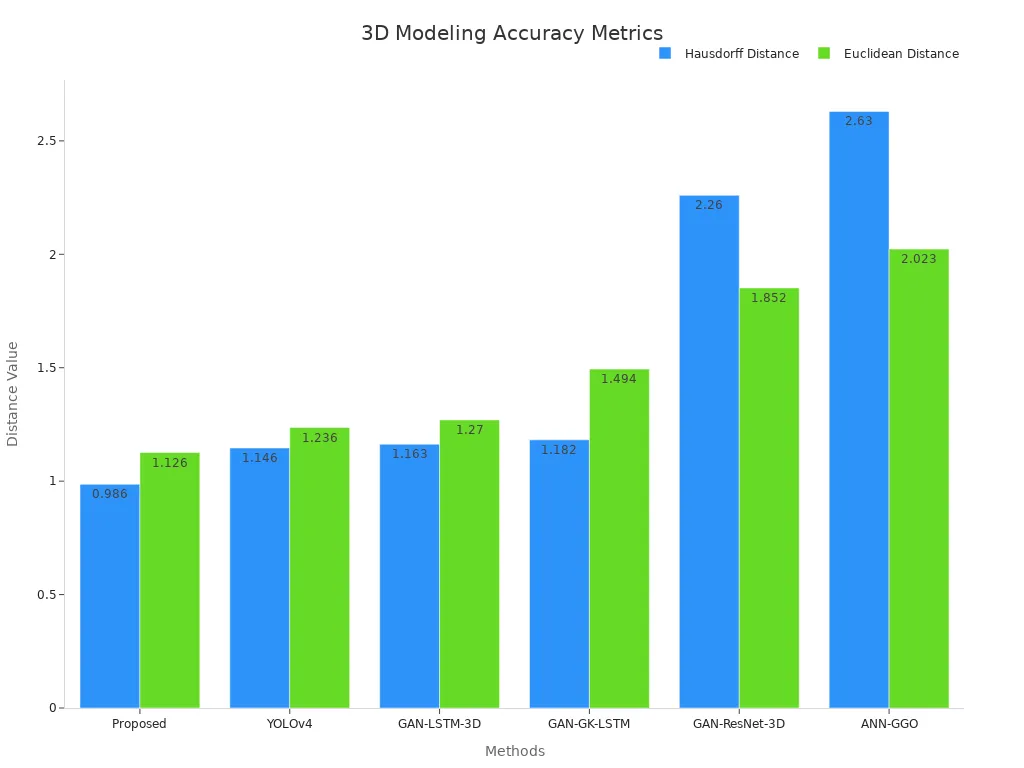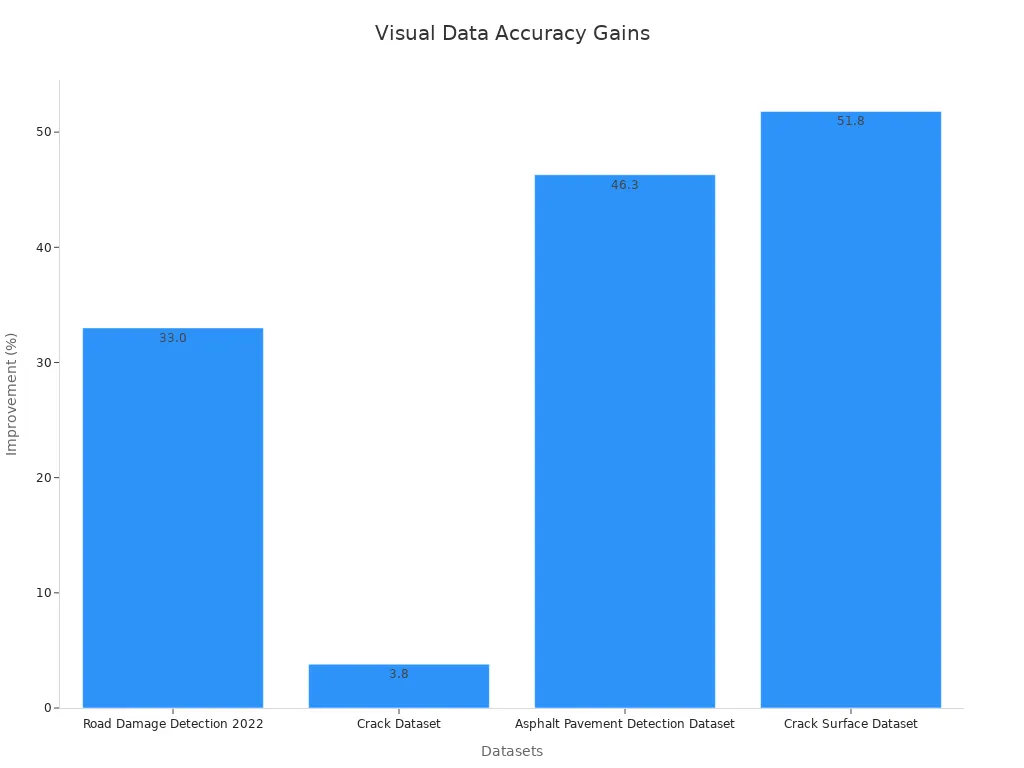
Generative adversarial networks (GANs) empower you to push the boundaries of machine vision. These networks allow systems to create realistic images, improve visual quality, and interpret data with unmatched precision. Their adversarial training method uses two models—the generator and the discriminator—to refine outputs continuously. This dynamic process solves challenges like image clarity and data scarcity, making GANs essential for advancing machine vision. With these capabilities, Generative Adversarial Network machine vision systems are transforming industries and redefining visual data processing.
Key Takeaways
- GANs help machine vision by making clear and realistic images.
- They use two parts, a generator and a discriminator, to improve results.
- GANs solve problems like not having enough data by creating fake datasets.
- They are used for making images, improving image quality, and testing systems.
- Even with issues like hard training and ethical worries, GANs are changing industries.
Understanding Generative Adversarial Networks
The Architecture of a Generative Adversarial Network
Generative adversarial networks (GANs) rely on a unique deep learning architecture that consists of two main components: the generator and the discriminator. These two neural networks work in opposition, creating a dynamic system often referred to as a "minimax game."
- Generator: This component starts with random noise and learns to create synthetic data that mimics real-world samples. It uses transposed convolution layers to generate high-quality images.
- Discriminator: This network evaluates whether the data it receives is real or fake. It uses standard convolution layers to analyze input data and improve its classification accuracy over time.
The training process alternates between these two networks. The generator tries to fool the discriminator, while the discriminator sharpens its ability to detect fake data. This adversarial setup ensures that both networks improve continuously.
| Component | Description |
|---|---|
| Generator | Transforms random noise into synthetic data, learning to produce realistic samples through training. |
| Discriminator | Classifies data as real or fake, improving its detection capabilities as training progresses. |
| Architecture | Composed of two neural networks (generator and discriminator) that compete in a minimax game. |
| Convolutional Networks | Utilizes CNNs for both generator (transposed convolution layers) and discriminator (standard convolution layers) to enhance image generation. |
| Training Process | Involves alternating training of both networks, focusing on balancing their performance. |
| Optimization Techniques | Uses SGD and variants like Adam for faster convergence; WGAN improves stability and reduces mode collapse. |
| Evaluation Metrics | Performance is assessed based on the quality of generated samples and the discriminator’s accuracy. |
This architecture has been pivotal in advancing machine vision tasks, enabling systems to generate realistic images and improve visual data processing.
Adversarial Training and Its Role in Machine Vision
Adversarial training is the core mechanism that powers GANs. It involves a competitive process where the generator and discriminator refine their abilities through constant feedback. This iterative process ensures that the generator produces increasingly realistic outputs, while the discriminator becomes more adept at distinguishing real from fake data.
In machine vision, adversarial training addresses several challenges:
- Image Quality: GANs enhance image resolution and clarity, making them ideal for applications like medical imaging and satellite imagery.
- Data Scarcity: By generating synthetic data, GANs help overcome the limitations of small or imbalanced datasets.
- Realism: The adversarial process ensures that generated images closely resemble real-world data, which is crucial for tasks like autonomous driving and facial recognition.
Recent studies highlight the effectiveness of adversarial training in machine vision:
- Achieved state-of-the-art results in semi-supervised classification on datasets like MNIST, CIFAR-10, and SVHN, with a human error rate of 21.3% for CIFAR-10 samples.
- The PGGAN method demonstrated significant improvements in both visual and quantitative evaluations compared to other methods.
This training approach not only enhances the performance of machine vision systems but also sets GANs apart from traditional AI models.
What Sets GANs Apart from Other AI Models
GANs stand out from other AI models due to their ability to generate new data rather than just analyzing existing data. Unlike traditional machine learning models, which rely heavily on labeled datasets, GANs can create synthetic data that mimics real-world samples. This capability makes them invaluable for tasks where data is scarce or expensive to obtain.
Comparative performance metrics further illustrate the superiority of GANs:
| Study | Task | Model Used | Performance Metrics |
|---|---|---|---|
| Abdulraheem et al. | Object Identification | Various GANs | Improved performance with GAN-generated datasets |
| Srivastav et al. | Chest X-ray Classification | VGG16 | 94.5% accuracy with augmented datasets |
| Qin et al. | Lung Disease Detection | ResNet, DenseNet, CNN | Enhanced classification performance with GAN datasets |
| Frid-Adar et al. | Liver Lesion Detection | CNN | 85.7% sensitivity, 92.4% specificity with GAN augmentation |
GANs also excel in generating high-resolution images, performing style transfer, and enabling realistic simulations. These capabilities make them a cornerstone of modern machine vision applications.

By leveraging their unique adversarial training process and deep learning architecture, GANs continue to redefine the possibilities of visual data processing.
Applications of GANs in Machine Vision
Image Generation and Synthesis
GANs have revolutionized image generation and synthesis by enabling the creation of realistic and high-quality images. These capabilities are particularly valuable in fields like medical imaging, entertainment, and design. You can use GANs to generate synthetic images that closely resemble real-world data, which is essential for tasks like training machine vision systems or creating visual content.
For example, in medical imaging, GANs can synthesize images of organs, tissues, or anomalies, helping researchers and practitioners analyze rare conditions without needing extensive datasets. A study titled "GANs for Medical Image Synthesis: An Empirical Study" tested various GAN architectures on cardiac cine-MRI, liver CT, and RGB retina images. The findings revealed that while some GANs excel at generating realistic medical images, others face challenges in replicating the complexity of medical datasets.
| Study Title | Focus Area | Key Findings |
|---|---|---|
| GANs for Medical Image Synthesis: An Empirical Study | Medical Imaging | Some GANs excel in generating realistic medical images, though segmentation accuracy varies. |
This ability to synthesize images has also found applications in creative industries. GANs can generate artwork, design prototypes, or even create virtual environments for video games and simulations. By leveraging GANs for image synthesis, you can unlock new possibilities in both scientific and artistic domains.
Data Augmentation for Machine Vision Systems
Data augmentation is a critical step in training machine vision systems, especially when datasets are limited or imbalanced. GANs offer a powerful solution by generating synthetic data that enhances the diversity and quality of training datasets. This approach improves the performance of machine vision models by exposing them to a broader range of scenarios.
For instance, if you are developing a machine vision system for facial recognition, GANs can create synthetic faces with varying expressions, lighting conditions, and angles. This enriched dataset helps the model generalize better, reducing errors in real-world applications. Similarly, in autonomous driving, GANs can generate diverse road scenarios, including rare conditions like foggy weather or nighttime driving, ensuring the system performs reliably under all circumstances.
By using GANs for data augmentation, you can overcome the challenges of limited datasets and improve the robustness of your machine vision system. This application highlights why GANs are indispensable for modern machine vision tasks.
Super-Resolution and Image Quality Enhancement
GANs play a pivotal role in super-resolution, a technique used to enhance the quality and resolution of low-resolution images. This application is particularly useful in fields like satellite imaging, medical diagnostics, and security surveillance, where high-resolution images are crucial for accurate analysis.
You can use GAN-based super-resolution models to restore details in blurry or pixelated images, making them clearer and more informative. For example, RealESRGAN, a state-of-the-art GAN model, has demonstrated exceptional performance in enhancing image quality. Other studies, such as those by Wang et al. and Zhang et al., have introduced innovative techniques like spatial feature transform layers and rank-content loss to further improve the perceptual quality of super-resolved images.
| Study | Contribution | Description |
|---|---|---|
| Wang et al. | Spatial Feature Transform Layer | Adjusts intermediate features using semantic segmentation maps. |
| Zhang et al. | Rank-Content Loss | Optimizes perceptual quality, achieving significant visual improvements. |
| Liu et al. | Channel Attention Mechanism | Enhances recovery of high-frequency details through optimized loss function. |
| Yu et al. | Convolutional Block Attention Module | Improves texture clarity by enhancing feature representation. |
These advancements make GANs a cornerstone for improving image quality in machine vision applications. Whether you are working with satellite images or medical scans, GANs can help you achieve sharper, more detailed visuals.
3D Modeling and Reconstruction
Generative adversarial networks have transformed 3D modeling and reconstruction by enabling systems to create accurate and detailed 3D representations from 2D images. This capability is essential in fields like architecture, gaming, and medical imaging, where precise 3D models are critical for analysis and visualization.
You can use GANs to reconstruct 3D objects by training them on datasets containing 2D images of objects from various angles. The generator creates 3D models, while the discriminator evaluates their accuracy by comparing them to real-world data. This adversarial process ensures continuous improvement in the quality of the generated models.
Metrics like Hausdorff Distance (HD) and Euclidean Distance (ED) are commonly used to measure the accuracy of 3D modeling and reconstruction. These metrics evaluate how closely the generated 3D models match the original objects. The table below highlights the performance of different methods in terms of HD and ED:
| Method | Hausdorff Distance (HD) | Euclidean Distance (ED) |
|---|---|---|
| Proposed | 0.986 | 1.126 |
| YOLOv4 | 1.146 | 1.236 |
| GAN-LSTM-3D | 1.163 | 1.270 |
| GAN-GK-LSTM | 1.182 | 1.494 |
| GAN-ResNet-3D | 2.260 | 1.852 |
| ANN-GGO | 2.630 | 2.023 |

These results demonstrate that GAN-based methods, such as GAN-LSTM-3D, outperform traditional approaches like YOLOv4 in generating accurate 3D models. By leveraging GANs, you can achieve high-quality 3D reconstructions that are both realistic and precise.
Style Transfer and Image-to-Image Translation
GANs have revolutionized style transfer and image-to-image translation by enabling seamless transformations between different visual styles or domains. These techniques are widely used in applications like photo editing, artistic rendering, and medical imaging.
Style transfer allows you to apply the visual characteristics of one image to another. For example, you can transform a photograph into a painting that mimics the style of Van Gogh or Picasso. GANs achieve this by learning the features of both the source and target styles, then generating a new image that combines elements of both.
Image-to-image translation, on the other hand, focuses on converting images from one domain to another. This includes tasks like turning sketches into realistic images, converting day scenes into night scenes, or translating medical scans into enhanced visualizations. GANs excel in this area due to their ability to generate high-quality and realistic outputs.
- GAN-based methods outperform existing state-of-the-art techniques in multi-domain image-to-image translation.
- They also surpass leading weakly-supervised localization methods in tasks like disease detection and localization.
These advancements highlight the versatility of GANs in handling complex visual transformations. Whether you are working on creative projects or scientific research, GANs provide powerful tools for style transfer and image-to-image translation.
Benefits of Generative Adversarial Networks in Machine Vision
Enhanced Accuracy in Visual Data Processing
Generative adversarial networks significantly improve the accuracy of visual data processing across various industries. By generating high-quality synthetic images, GANs enhance the ability of machine vision systems to detect and classify objects with precision. For example, in dental imaging, GANs synthesize periapical images, boosting classification accuracy for C-shaped root canals. Similarly, in autonomous driving, GANs enrich training datasets with diverse scenarios, ensuring robust system performance.
CycleGAN, a popular GAN model, has demonstrated exceptional performance in image processing tasks. It achieved a Frechet Inception Distance (FID) score of 103.49 and a Kernel Inception Distance (KID) score of 0.038 across 30 experiments. These metrics highlight the high quality of images generated by GANs, making them indispensable for visual data processing.
| Dataset | Improvement (%) |
|---|---|
| Road Damage Detection 2022 | 33.0 |
| Crack Dataset | 3.8 |
| Asphalt Pavement Detection Dataset | 46.3 |
| Crack Surface Dataset | 51.8 |

These advancements demonstrate how GANs elevate the performance of machine vision systems, enabling them to process visual data with remarkable accuracy.
Improved Efficiency in Training Machine Vision Models
GANs streamline the training process for machine vision models by generating synthetic data that reduces the need for extensive real-world datasets. This efficiency is measured using metrics like PSNR, SSIM, and FID. PSNR evaluates the quality of reconstructed images, while SSIM measures visual similarity. Higher values in these metrics indicate better performance.
By using GANs, you can train models faster and with fewer resources. For instance, GAN-generated datasets allow you to simulate complex scenarios, such as rare weather conditions for autonomous vehicles, without requiring real-world data collection. This approach not only saves time but also ensures that your models perform well in diverse environments.
Effective Use of Limited or Imbalanced Datasets
GANs excel in addressing the challenges of limited or imbalanced datasets. They generate synthetic samples that balance class distributions, improving the performance of machine vision models. For example, conditional GANs (CGANs) and Wasserstein GANs (cWGANs) have shown superior results in handling imbalanced datasets.
| Method | Performance Metrics | Datasets | Results |
|---|---|---|---|
| CGAN | AUC, geometric mean, F1 | Various | Highest mean composite ranking with statistically significant results. |
| cWGAN | AUC, AUC-PRC, Brier Score | Seven datasets | Outperformed SMOTE variants on five datasets. |
| ARIC | Accuracy, AUC, precision | Five datasets | Outperformed SMOTE and ADASYN on three datasets. |
| EWGAN | Accuracy | Vowel0, Page-blocks0 | Outperformed all other methods against baselines. |
The Model-Metric Mapper methodology (MMM) further highlights the effectiveness of GANs in resampling data distributions. By achieving near parity in class imbalance, GANs ensure that your machine vision models perform reliably, even with limited data.
Realistic Simulations for Testing and Development
Generative adversarial networks (GANs) have transformed the way you test and develop machine vision systems. By creating realistic simulations, GANs allow you to replicate complex environments and scenarios without relying on costly or time-consuming real-world data collection. These simulations are essential for refining systems that need to perform accurately in unpredictable conditions.
GANs generate synthetic data that mirrors real-world environments. This data helps you test machine vision models under diverse conditions, such as varying lighting, weather, or object placements. For example, if you are developing an autonomous vehicle system, GANs can simulate scenarios like foggy roads or crowded intersections. These simulations ensure your model performs reliably in real-world situations.
Tip: GANs reduce computation time significantly, enabling near-instantaneous simulation results. This speed is crucial for real-time data analysis and iterative testing.
You can also use GANs to enhance existing datasets by simulating user behaviors or environmental changes. This process improves the quality of your testing data, making it more representative of real-world challenges. For instance, GANs can simulate pedestrian movements or vehicle interactions, enriching datasets for traffic analysis systems.
- GAN-based methods provide large volumes of synthetic data that closely resemble real-world scenarios.
- Simulations created by GANs improve testing processes, ensuring models perform well under diverse conditions.
- GANs enhance original datasets by replicating real-world environments and user behaviors.
These capabilities make GANs indispensable for testing and development. Whether you are working on security systems, medical imaging, or autonomous technologies, GANs offer a powerful tool to create realistic simulations that push your machine vision models to their full potential.
Challenges of Using GANs in Machine Vision
Training Instability and Mode Collapse
Training GANs often presents challenges due to instability and mode collapse. These issues occur when the generator produces repetitive outputs or fails to converge during adversarial training. You may notice fluctuations in loss values, especially when the latent space is set to 1 and the model is trained for 200 epochs. High learning rates, such as 0.01, can exacerbate these problems, leading to non-convergence or mode collapse. Lower rates, like 0.0002, are recommended to stabilize training dynamics.
Mode collapse impacts the diversity of generated outputs, making them less useful for tasks like object detection or image synthesis. For example, a GAN trained for 300 epochs may output random noise instead of realistic images, highlighting unstable training dynamics. Quantitative metrics like the NDB score help evaluate mode collapse, with values closer to 1 indicating severe issues. Addressing these challenges requires careful tuning of hyperparameters and optimization techniques to ensure reliable adversarial training.
High Computational and Resource Costs
GANs demand significant computational resources, making them expensive to train and deploy. You need high-performance GPUs or TPUs to handle the complex adversarial training process. The generator and discriminator networks require substantial memory and processing power, especially for high-resolution image generation or 3D modeling tasks.
Training GANs also consumes time. Models often need thousands of epochs to achieve convergence, which increases energy consumption and operational costs. For instance, generating high-quality images for object detection may require weeks of training on advanced hardware. These resource-intensive requirements limit the accessibility of GANs for smaller organizations or individual researchers. Efficient architectures and techniques, such as lightweight GAN models, can help reduce computational demands while maintaining performance.
Ethical Concerns in GAN Applications
The use of GANs raises ethical concerns, particularly in sensitive fields like medical imaging and construction. Biases in training data can lead to misrepresentation, affecting gender or ethnicity in generated outputs. For example, generative AI in nuclear medicine has faced criticism for producing biased results that compromise ethical standards. These biases can impact object detection accuracy and lead to unfair outcomes in applications like facial recognition or healthcare diagnostics.
In construction, ethical challenges arise when GANs generate synthetic data that misrepresents real-world conditions. This can lead to flawed decision-making or safety risks. Addressing these concerns requires strict guidelines for data collection and model training. You must ensure that GANs are used responsibly, with transparency in their applications to avoid ethical misrepresentation.
Managing and Controlling Output Quality
Controlling the output quality of generative adversarial networks (GANs) is essential for ensuring reliable results in machine vision applications. You can achieve this by implementing strategies that refine the training process and enhance the precision of generated outputs. One effective approach involves using conditional GANs (cGANs), which allow you to generate data with specific characteristics. These models excel at tailoring outputs to meet predefined criteria, making them highly effective for quality control.
For instance, cGANs have been used to optimize processing parameters in manufacturing processes like directed energy deposition for Ti-6Al-4V alloys. By training on image samples with varied parameters, cGANs can predict surface morphology and ensure consistent quality. This capability highlights their potential to manage output quality in diverse fields, from industrial applications to medical imaging.
To further improve output quality, you should focus on fine-tuning hyperparameters such as learning rates and batch sizes. Smaller learning rates often stabilize training, reducing the risk of mode collapse. Additionally, incorporating advanced loss functions, like Wasserstein loss, can help maintain a balance between the generator and discriminator, ensuring more realistic outputs.
You can also monitor output quality using metrics like Frechet Inception Distance (FID) and Structural Similarity Index Measure (SSIM). These tools evaluate the realism and accuracy of generated images, providing valuable feedback for model adjustments. Regularly assessing these metrics helps you identify and address issues early in the training process.
Tip: Always validate your GANs on diverse datasets to ensure they generalize well across different scenarios. This practice minimizes biases and enhances the reliability of your machine vision system.
By adopting these strategies, you can effectively manage and control the output quality of GANs, ensuring they deliver consistent and high-quality results.
The Future of Generative Adversarial Network Machine Vision Systems

Innovations in GAN Architectures
You can expect exciting advancements in GAN architectures that will redefine machine vision capabilities. Researchers are developing techniques to generate ultra-realistic images with higher resolution and greater texture fidelity. Attention mechanisms, for instance, allow GANs to focus on fine-grained details, improving the quality of generated outputs. These innovations are particularly impactful in fields like medical imaging, where GANs create augmented datasets to aid in disease detection and treatment planning.
Other industries are also benefiting from these advancements. Financial modeling uses GANs to simulate market scenarios, helping organizations assess risks and optimize strategies. These trends highlight how GANs are evolving to meet the growing demand for precision and realism in machine vision applications.
- Higher resolution outputs are becoming standard, thanks to enhanced training strategies.
- Attention mechanisms improve detail and texture fidelity in generated images.
- GANs are transforming industries like healthcare and finance by creating synthetic data for critical applications.
Integration with Emerging AI Technologies
The integration of GANs with other AI technologies is unlocking new possibilities in machine vision. For example, combining GANs with reinforcement learning enables systems to adapt and improve in real-time. This synergy enhances applications like autonomous vehicles, where GANs simulate diverse driving conditions while reinforcement learning optimizes decision-making.
Case studies demonstrate the transformative potential of these integrations:
| Case Study | Industry | Description |
|---|---|---|
| Revolutionizing healthcare imaging | Healthcare | GANs generate high-resolution images from low-quality scans, improving diagnostics. |
| Enhancing creative content | Entertainment | GANs create realistic CGI characters and immersive virtual environments. |
| Financial forecasting | Finance | GANs simulate market scenarios, aiding in risk management and investment strategies. |
These examples show how GANs, when paired with emerging AI technologies, can revolutionize industries by enhancing efficiency and accuracy.
Real-Time Applications in Machine Vision
Real-time applications of GANs are becoming increasingly feasible as computational power grows. You can now use GANs to process and analyze visual data instantly, making them ideal for tasks like video surveillance, autonomous navigation, and augmented reality. For instance, GANs can enhance live video feeds by improving resolution or removing noise, ensuring clearer visuals for decision-making.
In autonomous vehicles, real-time GANs simulate road conditions, helping systems adapt to unexpected scenarios. Similarly, in augmented reality, GANs generate realistic overlays that blend seamlessly with the real world. These applications demonstrate how GANs are pushing the boundaries of what machine vision systems can achieve in real-time environments.
Note: As GANs continue to evolve, their ability to handle real-time tasks will only improve, opening doors to even more innovative applications.
Addressing Ethical and Technical Challenges
Generative adversarial networks offer groundbreaking capabilities, but they also present ethical and technical challenges that you must address to ensure responsible use. These challenges include privacy concerns, computational demands, and the need for governance mechanisms.
Privacy remains a significant issue in generative AI. Models often require vast datasets, which can include sensitive information. Generative adversarial networks, with billions of parameters, demand substantial computational power. This reliance on third-party tools raises ethical concerns about data security. Only 7 papers, or 5.9% of recent research, have proposed localized architectures as a way to mitigate these risks. By adopting localized systems, you can reduce dependency on external platforms and enhance data privacy.
The computational demands of GANs also pose technical hurdles. Training these networks requires high-performance hardware, which consumes significant energy. This not only increases costs but also raises environmental concerns. To address this, you can explore lightweight GAN architectures that maintain performance while reducing resource consumption.
Governance mechanisms play a crucial role in ensuring ethical implementation. Frameworks aligned with strategies like the National Digital Health Strategy emphasize the importance of ethical standards. These guidelines help you navigate the complexities of deploying GANs in sensitive fields like healthcare. For example, when generating high-resolution images for medical diagnostics, adhering to these standards ensures fairness and accuracy.
To overcome these challenges, you should prioritize transparency in data collection, invest in efficient architectures, and follow established ethical guidelines. By doing so, you can harness the full potential of generative adversarial networks while minimizing risks.
Generative adversarial networks are reshaping the landscape of machine vision by enabling systems to generate, enhance, and interpret visual data with remarkable precision. These networks, powered by adversarial learning, have demonstrated their ability to produce realistic outputs, such as 3D models reconstructed from 2D images. For instance, MapGANs excel at transforming 2D images into 3D models, which is invaluable for industries like healthcare, automotive, and entertainment. In healthcare, they assist in creating 3D organ models for surgical planning. In the automotive sector, they enhance vehicle design and testing. Entertainment benefits from their role in crafting realistic characters and environments.
Despite challenges like training instability and ethical concerns, advancements in deep learning and image processing continue to refine generative adversarial network machine vision systems. Models like CycleGAN achieve high-quality results with low FID and KID scores, proving their effectiveness in image recognition tasks. As these systems evolve, their applications will expand, offering groundbreaking solutions across industries.
Note: The future of generative adversarial network machine vision systems is bright, with the potential to revolutionize how machine learning models process and utilize visual data.
FAQ
What makes GANs unique compared to other AI models?
GANs generate new data instead of just analyzing existing data. This ability allows you to create synthetic datasets, enhance image quality, and simulate realistic scenarios. Unlike traditional models, GANs use adversarial training, where two networks compete to improve output quality continuously.
How do GANs improve machine vision systems with limited data?
GANs create synthetic data to balance or expand small datasets. This helps you train machine vision models more effectively, even when real-world data is scarce. By generating diverse samples, GANs ensure your system performs well across various scenarios.
Are GANs suitable for real-time applications?
Yes, advancements in computational power make GANs increasingly viable for real-time tasks. You can use them for live video enhancement, autonomous navigation, or augmented reality. These applications benefit from GANs’ ability to process and generate visual data instantly.
What are the main challenges of training GANs?
Training GANs can be unstable due to issues like mode collapse, where outputs lack diversity. High computational demands also pose challenges. To address these, you should fine-tune hyperparameters, use advanced loss functions, and ensure access to powerful hardware.
How do GANs handle ethical concerns in machine vision?
You can mitigate ethical concerns by ensuring diverse and unbiased training datasets. Transparent data collection and adherence to ethical guidelines help you avoid biases in GAN-generated outputs. Responsible use of GANs ensures fairness and accuracy in sensitive applications like healthcare or security.
See Also
Understanding The Importance Of Triggering In Machine Vision
An Overview Of Cameras Used In Machine Vision Systems
The Importance Of Machine Vision Systems In Bin Picking
Exploring The Role Of Pixel Machine Vision Today
Navigating Semiconductor Machine Vision Systems: A Comprehensive Guide








